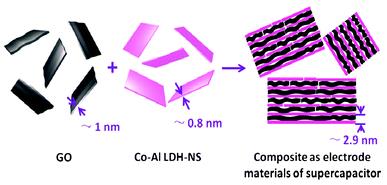Since the Yangshao Culture (5000-3000 BC), ancient Chinese living in the Yellow River Basin began to use natural layered materials to make pottery, such as bowls, oysters, and oysters. The invention of pottery symbolized the beginning of the Neolithic Age. At the same time, it was the first time in the history of mankind that a layered material was used and a new thing was created according to its own will. With the study of layered materials, more and more layered materials have been discovered and used, such as graphite, montmorillonite, layered sulfides, layered metal hydroxides, and the like.
Among them, the layered metal hydroxide is an anionic layered compound, and the metal is mostly a transition metal such as cobalt, nickel, and iron. Like most lamellar materials, layered metal hydroxides can also be stripped into a two-dimensional structure of monolayers, with a thickness of only about 1 nanometer. Because of its large specific surface area, this monolayered metal hydroxide exhibits a very excellent application prospect in the field of electrochemistry and has received extensive attention from various research groups at home and abroad. However, since the two-dimensional material itself has a large surface energy, self-stacking often occurs during the preparation of the electrode. This phenomenon of “self-stacking†greatly limits the use of this material in the electrochemical field. application.
Researcher Qi Jian of the Institute of Nanotechnology and Nano-Bionics of the Chinese Academy of Sciences, Suzhou University, proposed a method for preparing a full two-dimensional supercapacitor electrode by using its own surface charge for intercalation and assembly of heterogeneous materials. The "self-stacking" phenomenon was successfully avoided during the preparation of the electrode. First, the research team used the charge difference between graphene oxide and monolayer cobalt hydroxide to conduct electrostatic force-induced layer self-assembly of two two-dimensional materials (as shown in Figure 1), and obtained superior performance. Supercapacitor electrode materials, related work was published in Chem. Commun. 2011, 47, 3556-3558. and Langmiur 2012, 28, 293-298.

Fig.1 Preparation of layered graphene oxide and monolayer cobalt hydroxide composites
Since aluminum atoms are used as supercapacitor electrodes and lack electrochemical activity, resulting in a decrease in material mass specific capacity, in order to continue to improve the performance of supercapacitors, the research group prepared α-phase layered cobalt hydroxide and passed small molecule ligands. By adjusting the interlayer spacing of the α-layered cobalt hydroxide, a layer of cobalt hydroxide with a layer spacing of 1.6, 0.7, and 0.09 nanometers was prepared. The influence of the layer spacing effect on the tantalum capacitor activity was systematically studied (eg, Figure 2). Related work was published in Adv. Funct. Mater. 2013, 23, 2758-2764.

Fig. 2 (a) Scanning electron micrograph of the α-phase layered cobalt hydroxide; (b) A schematic diagram of the structure of the α-phase layered cobalt hydroxide of different layer spacings.
Subsequently, during the exfoliation of the cobalt phase of the α-phase layered cobalt hydroxide, the research team first observed the phase transition of cobalt hydroxide during the stripping process, and successfully produced a single-layer β-phase cobalt hydroxide with a thickness of only about 1 nanometer for the first time. For nanoplates, the yield is close to 100% (as shown in Figure 3). A two-dimensional composite electrode of reduced graphene oxide and a single-layer β-phase cobalt hydroxide nanosheet was prepared by self-assembling the graphene oxide layer by electrostatic force, and the composite electrode material exhibited excellent tantalum capacitor activity. Related work was published on the ACS Nano DOI:10.1021/nn500386u.

Fig. 3 (a) Schematic diagram of phase transition of α-phase layered cobalt hydroxide to β-phase cobalt hydroxide nanosheets; (b) Change in color caused by phase inversion during stripping.
This series of work was supported by the National Natural Science Foundation of China (21004076), the "973" Major Research Plan (2013CB933000) and the Key Deployment Project of the Chinese Academy of Sciences (KJZD-EW-M01-3).
Ultra Plantâ„¢ Grow Light offers One Chip Technology aimed to meet your indoor growing expectation such as improve plants' quality, increase yield, or better the margin, etc., all for helping you realize a higher return on your crops.
Ultra Plantâ„¢ Grow Light is combined our advanced All-In-One technology with patented optical design and customized light full spectrum supported from our experienced LED engineers, plant specialists and other partners working on horticulture.
From Ultra Plantâ„¢ APP, you are able to schedule the growing process including photoperiod, brightness and spectral in advance. The lighting system will help you grow smarter, easier and better.
Ultra Plantâ„¢ is the most versatile horticultural grow lighting fixture for indoor plants with flexible full spectrum, brightness control and uniform, wider light distribution, suitable for top lighting of all types of crops. No matter it applies to anywhere for any crop, Ultra Plantâ„¢ can do perfect work for you.
Grow Light On Hemp,Hemp Grow Lights,Hemp Led Grow Lights,Best Grow Light On Hemp
Feton Corporation , https://www.fetonledlight.com